Abstract
The Southern Uplands-Down-Longford Terrane in southeast Northern Ireland is prospective for Caledonian-age, turbidite-hosted orogenic gold mineralisation with important deposits at Clontibret in the Republic of Ireland and in Scotland. Geochemical and geophysical data from the DETI-funded Tellus project have been used, in conjunction with other spatial geoscience datasets, to map the distribution of prospectivity for this style of mineralisation over this terrane. A knowledge-based fuzzy logic modelling methodology using Arc Spatial Data modeller was utilised. The prospectivity analysis has identified several areas prospective for turbidite-hosted gold mineralisation, comparable to that at Clontibret and gold occurrences in the Southern Uplands of Scotland. A number of these either coincide with known bedrock gold occurrences or with areas considered prospective and targeted by previous exploration work, validating the predictive capability of the exploration model devised and its translation into a GIS-based prospectivity model. The results of the modelling suggest that as in other parts of the Southern Uplands the coincidence of regional strike-parallel structures and intersecting transverse faults are highly prospective, as these are likely to create zones of anomalous stress for fluid flow and deposit formation. Those areas in which there are no known gold occurrences are considered to be favourable targets for further exploration and should be followed up.









Similar content being viewed by others
References
An, P., Moon, W. M., & Rencz, A. (1991). Application of fuzzy set theory for integration of geological, geophysical and remote sensing data. Canadian Journal Exploration Geophysics, 27(1), 1–11.
Anderson, T. B. (2004). Southern Uplands-Down-Longford Terrane. In W. I. Mitchell (Ed.), The geology of Northern Ireland our natural foundation (2nd ed., pp. 10–60). Belfast: Geological Survey of Northern Ireland.
Anderson, T. B., & Oliver, G. J. H. (1986). The Orlock Bridge Fault: A major Late Caledonian sinistral fault in the Southern Uplands Terrane, British Isles. Transactions of the Royal Society of Edinburgh: Earth Sciences, 77(5), 203–222.
Appleton, J. D., Rawlins, B. G., & Thornton, I. (2008). National-scale estimation of potentially harmful element ambient background concentrations in topsoil using parent material classified soil: stream–sediment relationships. Applied Geochemistry, 23(9), 2596–2611.
Arthurs, J. W., & Earls, G. (2004). Minerals. In W. I. Mitchell (Ed.), The geology of Northern Ireland our natural foundation (2nd ed., pp. 255–272). Belfast: Geological Survey of Northern Ireland.
Ash, C., & Alldrick, D. (1996). Au-quartz Veins. In D. V. Lefebure & T. Hõy (Eds.), Selected British Columbia mineral deposit profiles, Volume 2—Metallic Deposits (pp. 53–56). British Columbia Ministry of Employment and Investment, Open File 1996-13.
Barnes, R. P., Phillips, E. R., & Boland, M. P. (1995). The Orlock Bridge Fault in the Southern Uplands of southwestern Scotland: a terrane boundary? Geological Magazine, 132(5), 523–529.
Baron, M., & Parnell, J. (2005). Fluid evolution in base-metal sulphide mineral deposits in the metamorphic basement rocks of southwest Scotland and Northern Ireland. Geological Journal, 40(1), 3–21.
Beamish, D., Cuss, R. J., Lahti, M., Scheib, S., & Tartaras, E. (2007). The Tellus airborne geophysical survey of Northern Ireland, final processing report. British Geological Survey, Internal Report IR/06/136.
Bierlein, F. P., & Crowe, D. E. (2000). Phanerozoic orogenic lode gold deposits. In S. G. Hagemann & P. E. Brown (Eds.), Gold in 2000 (pp. 103–109). SEG Reviews, 13.
Boast, A. M., Harris, M., & Steffe, D. (1990). Intrusive-hosted gold mineralization at Hare Hill, Southern Uplands, Scotland. Transactions of the Institution of Mining and Metallurgy Section B Applied Earth Science, 99, 106–112.
Bonham-Carter, G. F. (1994). Geographical information system for geoscientists: modelling with GIS. London: Pergamon.
Carranza, E. J. M., & Hale, M. (2001). Geologically constrained fuzzy mapping of gold mineralisation potential, Baguio District. Philippines. Natural Resources Research, 10(2), 125–136.
Cooper, M. R., & Johnston, T. P. (2004a). Late Palaeozoic intrusives. In W. I. Mitchell (Ed.), The geology of Northern Ireland our natural foundation (2nd ed., pp. 61–88). Belfast: Geological Survey of Northern Ireland.
Cooper, M. R., & Johnston, T. P. (2004b). Palaeogene intrusive igneous rocks. In W. I. Mitchell (Ed.), The geology of Northern Ireland our natural foundation, 2nd Edition (pp. 179–198) (2nd ed., pp. 179–198). Belfast: Geological Survey of Northern Ireland.
Cooper, D. C., Rollin, K. E., Colman, T. B., Davies, J. R., & Wilson, D. (2000). Potential for mesothermal gold and VMS deposits in the Lower Palaeozoic Welsh Basin. BGS Research Report RR/00/09.
Cruise, M., & Farrell, L. P. C. (1993). Exploration focus – Clontibret, MINFO 10/93. Dublin: Exploration and Mining Division Department of Transport, Energy and Communication.
Curtis, S. F., Pattrick, R. A. D., Jenkin, J. R. T., Fallick, A. E., Boyce, A. J., & Treagus, J. E. (1993). Fluid inclusion and stable isotope study of fault-related mineralization in Tyndrum area, Scotland. Transactions of the Institution of Mining and Metallurgy Section B Applied Earth Science, 102, 39–47.
D’Ercole, C., Groves, D. I., & Knox-Robinson, C. M. (2000). Using fuzzy logic in a Geographic Information System environment to enhance conceptually based prospectivity analysis of Mississippi Valley-type mineralisation. Australian Journal of Earth Sciences, 47(5), 913–927.
Duller, P. R., Gallagher, M. J., Hall, A. J., & Russell, M. J. (1997). Glendinning deposit—an example of turbidite-hosted arsenic–antimony–gold mineralization in the Southern Uplands, Scotland. Transactions of the Institution of Mining and Metallurgy Section B Applied Earth Science, 106, 119–134.
Flight, D. M. A., & Lister, T. R. (2009). Stream sediment geochemistry. In M. E. Young (Ed.), Understanding underground: A geoscience atlas of Northern Ireland. Belfast: Geological Survey of Northern Ireland.
Gallagher, M. J., Stone, P., Kemp, A. E. S., Hills, M. G., Jones, R. C., Smith, R. T., Peachey, D., Vickers, B. P., Parker, M. E., Rollin, K. E. & Skilton, B. R. H. (1983). Stratabound arsenic and vein antimony mineralisation in Silurian greywackes at Glendinning, south Scotland. Institute Geological Sciences Mineral Reconnaissance Programme Report, 59.
Goldfarb, R. J., Baker, T., Dubé, B., Groves, D. I., Hart, C. J. R., & Gosselin, P. (2005). Distribution, character, and genesis of gold deposits in metamorphic terranes. In J. W. Hednquist, J. F. H. Thompson, R. J. Goldfarb, & J. P. Richards (Eds.), Economic geology one hundredth anniversary volume (pp. 407–450). Littleton, CO: Society of Economic Geologists.
Goldfarb, R. J., Groves, D. I., & Gardoll, S. (2001). Orogenic gold and geologic time: A global synthesis. Ore Geology Reviews, 18(1–2), 1–75.
Gregory, P. (1972). Summary report for licence areas B1, B2, B3, B4 and B5 for the year ending 24th January 1972.
Grennan, E. F. (1989). Ards Mineral Prospecting Licence NW1 Report (Year 2). North West Minerals Ltd.
Groves, D. I., Goldfarb, R. J., Knox-Robinson, C. M., Ojala, J., Gardoll, S., Yun, G. Y., et al. (2000). Late kinematic timing of orogenic gold deposits and significance for computer-based exploration techniques with emphasis on the Yilgarn Block, Western Australia. Ore Geology Reviews, 17, 1–38.
Gunn, A. G., & Plant, J. A. (1998). Multidataset analysis for the development of gold exploration models in western Europe. British Geological Survey Research Report SF/98/1.
Gunn, A. G., & Rollin, K. E. (2000), Exploration methods and new targets for epithermal gold mineralisation in the Devonian rocks of Northern Britain. British Geological Survey Research Report RR/00/008.
Gunn, A. G., Wiggans, G. N., Collins, G. L., Rollin, K. E., & Coats, J. S. (1997). Artificial Intelligence in mineral exploration and development: potential applications by SMEs in Britain. British Geological Survey Technical Report WF/97/3C.
Hugall, J. N. 2010. Gold and Base-Metal Sulphide Prospectivity of the Southern Uplands-Down-Longford Terrane, North County Down, Northern Ireland. University of Southampton unpublished MSc. thesis.
Johnson, C. C., Breward, N., Ander, E. L., & Ault, L. (2005). G-BASE: baseline geochemical mapping of Great Britain and Northern Ireland. Geochemistry: Exploration Environment and Analysis, 5, 347–357.
Knox-Robinson, C. M. (2000). Vectorial fuzzy logic: a novel technique for enhanced mineral prospectivity mapping, with reference to the orogenic gold mineralisation potential of the Kalgoorlie Terrane, Western Australia. Australian Journal of Earth Sciences, 47(5), 929–941.
Leake, R. C., Rollin, K. E., & Shaw, M. C. (1996). Assessment of the potential for gold mineralisation in the Southern Uplands of Scotland using multiple geological, geophysical and geochemical datasets. British Geological Survey, Mineral Reconnaissance Programme Report, 141.
Leggett, J. K., Morris, J. H., Oliver, G. J. H., & Phillips, W. E. A. (1979). The north-western margin of the Iapetus Ocean. In A. L. Harris, C. H. Holland, & B. E. Leake (Eds.), The Caledonides of the British Isles-reviewed (pp. 499–512). London: Geological Society. Special Publication, 8.
Leyshon, P. (1972). A report on a Mineral Exploration Programme in the Riofinex, Newry Licence Areas NW1, 2 and 3 Co. Down, Northern Ireland. Riofinex Ltd.
Lowry, D., Boyce, A. J., Fallick, A. E., & Stephens, W. E. (1997). Sources of sulphur, metals and fluids in granitoid-related mineralization of the Southern Uplands, Scotland. Transactions of the Institution of Mining and Metallurgy Section B Applied Earth Science, 106, 157–168.
McArdle, P. (1989). Geological setting of gold mineralization in the Republic of Ireland. Transactions of the Institution of Mining and Metallurgy Section B Applied Earth Science., 98, 7–12.
Morris, J. H., Steed, G. M., & Wilbur, D. G. (1986). The Lisglassan-Tullybuck deposit, County Monaghan: Sb–As–Au vein mineralization in Lower Palaeozoic greywackes. In C. J. Andrew, R. W. A. Crowe, S. Finlay, W. M. Pennel, & J. F. Pyne (Eds.), Geology and genesis of mineral deposits in Ireland (pp. 103–120). Dublin: Irish Association of Economic Geology.
Mukhopadhyay, B., Saha, A., & Niladri, H. (2003). Knowledge driven GIS modelling techniques for copper prospectivity mapping in Singhbhum Copper Belt—a retrospection: Map India conference.
Mullin, H., 2001, A gold reconnaissance survey of the Slieve Croob area, Co. Down, Northern Ireland. GSNI Technical Report.
Murphy, F. C. (1987). Late Caledonian granitoids and timing of deformation in the Iapetus suture zone of eastern Ireland. Geological Magazine, 124(2), 135–142.
Naden, J., & Caulfield, J. B. D. (1989). Fluid inclusion and isotopic studies of gold mineralization in the Southern Uplands of Scotland. Transactions of the Institution of Mining and Metallurgy Section B Applied earth science, 98, 46–48.
Nesbitt, B. E. (1993). Phanerozoic gold deposits. In R. P. Foster (Ed.), Gold metallogeny and exploration (pp. 104–132). London: Chapman & Hall.
Nykanen, V. M., Groves, D. I., Ojala, V. J., Eilue, P., & Gardoll, S. J. (2008). Reconnaissance-scale conceptual fuzzy-logic prospectivity modelling for iron oxide copper-gold deposits in the northern Fennoscandian Shield. Finland Australian Journal of Earth Sciences, 55(1), 25–38.
Nykanen, V. M., & Ojala, V. J. (2007). Spatial data mining techniques as mineral exploration tools: Examples from gold exploration in the northern Fennoscandian Shield, Finland. Proceedings of the Ninth Biennial SGA Meeting, Dublin (pp. 671–674).
Porwal, A., Carranza, E. J. M., & Hale, M. (2003). Knowledge-driven and data-driven fuzzy models for predictive mineral potential mapping. Natural Resources Research, 12(1), 1–25.
Porwal, A., & Kreuzer, O. P. (2010). Introduction to the Special Issue: Mineral prospectivity analysis and quantitative resource estimation. Ore Geology Reviews, 38(3), 121–127.
Purcell, W., Wheeler, P., & Harisson, A. (2007). Conroy Diamonds and Gold plc Initiation Report. Objective Capital.
Raines, G. L., & Bonham-Carter, G. F. (2006). Exploratory spatial modelling: demonstration for Carlin-type deposits, central Nevanda, USA, using Arc-SDM. In J. R. Harris (Ed.), GIS for the earth sciences (pp. 23–52). Geological Association of Canada Special Paper, 44.
Rock, N. M. S., & Groves, D. I. (1988). Can lamprophyres resolve the genetic controversy over mesothermal gold deposits? Economic Geology, 16(6), 538–541.
Rogge, D. M., Halden, N. M., & Beaumont-Smith, C. (2006). Application of data integration for shear-hosted Au potential modelling: Lynn Lake Greenstone Belt, Northwestern, Manitoba, Canada. In J. R. Harris (Ed.), GIS for the earth sciences (pp. 191–210). Geological Association of Canada Special Paper, 44.
Sawatzky, D. L., Raines, G. L., Bonham-Carter, G. F., & Looney C. G. (2008). Spatial Data Modeller (SDM): ArcMAP 9.2 geoprocessing tools for spatial data modelling using weights of evidence, logistic regression, fuzzy logic and neural networks. http://arcscripts.esri.com/details.asp?dbid=15341.
Shepherd, T. J., & Bottrell, S. H. (1993). Dolgellau Gold-belt, Harlech district, North Wales. In R. A. D. Pattrick & D. A. Polya (Eds.), Mineralization in the British Isles (pp. 187–207). London: Chapman & Hall.
Smith, C. G., Smith, R. T., Leake, R. C., Styles, M. T., & Legg, I. C. (1996). Mineral exploration in the Hilltown and Slieve Croob areas, County Down. Geological Survey of Northern Ireland Technical Report GSNI/96/2.
Steed, G. M., & Morris, J. H. (1986). Gold mineralization in Ordovician greywackes at Clontibret, Ireland. In J. D. Keppie, R. W. Boyle & S. J. Haynes (Eds.), Turbidite-hosted gold deposits (pp. 67–86). Geological Association of Canada Special Paper, 32.
Steed, G. M., & Morris, J. H. (1997). Isotopic evidence for the origins of a Caledonian gold–arsenopyrite–pyrite deposit at Clontibret, Ireland. Transactions of the Institution of Mining and Metallurgy Section B Applied earth science, 106, 59–204.
Stone, P., Cook, J. M., McDermott, C., Robinson, J. J., & Simpson, P. R. (1995). Lithostratigraphic and structural controls on distribution of As and Au in southwest Southern Uplands, Scotland. Transactions of the Institution of Mining and Metallurgy Section B Applied earth science, 104, 111–119.
Stone, P., Floyd, J. D., Barnes, R. P., & Lintern, B. C. (1987). A sequential; back-arc and foreland basin thrust duplex model for the Southern Uplands of Scotland. Journal of the Geological Society of London, 144(5), 753–764.
Tangestani, M. H., & Moore, F. (2003). Mapping porphyry copper potential with a fuzzy model, northern Shahr-e-Babak. Iran Australian Journal of Earth Sciences, 50(3), 311–317.
Toal, P. (1988). Report on the stream sediment geochemistry of the Jerretts pass area.
Toal, P., & Reid, C. G. (1986). Progress report on geological examination and gold panning studies on licence AR4, Co. Down.
Wilkinson, J. J., Boyce, A. J., Earls, G., & Fallick, A. E. (1999). Gold remobilization by low-temperature brines: evidence from the Curraghinalt gold deposit, Northern Ireland. Economic Geology, 94, 289–296.
Young, R. D. (1987). Report on Andaman Resources Licence area AR4 (the Castlewellan-Slieve Croob area).
Zadeh, L. A. (1965). Fuzzy Sets. Information and Control, 8, 338–353.
Acknowledgments
The authors acknowledge the support of Geological Survey of Northern Ireland and the Tellus project team. PL, CS, AG and AW publish with the permission of the Executive Director, British Geological Survey (NERC). Tim Colman is thanked for his valuable comments on the draft text. The Tellus Project was financed by the Department of Enterprise, Trade and Investment of Northern Ireland and by the EU-funded Rural Development Programme 2001–2006 for Building Sustainable Prosperity. Maps are based upon Crown Copyright and reproduced with the permission of Land & Property Services under delegated authority from the Controller of Her Majesty’s Stationery Office, © Crown copyright and database right (2012) DMOU205. Crown copyright 2012. All rights reserved.
Author information
Authors and Affiliations
Corresponding author
Rights and permissions
About this article
Cite this article
Lusty, P.A.J., Scheib, C., Gunn, A.G. et al. Reconnaissance-Scale Prospectivity Analysis for Gold Mineralisation in the Southern Uplands-Down-Longford Terrane, Northern Ireland. Nat Resour Res 21, 359–382 (2012). https://doi.org/10.1007/s11053-012-9183-3
Received:
Accepted:
Published:
Issue Date:
DOI: https://doi.org/10.1007/s11053-012-9183-3




